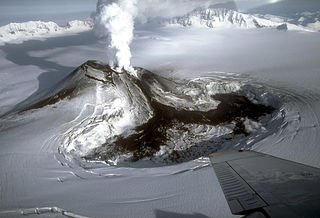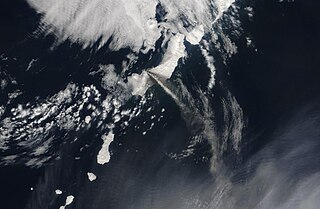
Klyuchevskaya Sopka is a stratovolcano, the highest mountain on the Kamchatka Peninsula of Russia and the highest active volcano of Eurasia. It is the highest mountain in Siberia. Its steep, symmetrical cone towers about 100 kilometres (60 mi) from the Bering Sea. The volcano is part of the natural Volcanoes of Kamchatka UNESCO World Heritage Site.

Below is a list of (almost) all volcanoes in the world.

Atlasov Island, known in Russian as Ostrov Atlasova (Остров Атласова), or in Japanese as Araido (阿頼度島), is the northernmost island and volcano and also the highest volcano of the Kuril islands, part of the Sakhalin Oblast in Russia. The Russian name is sometimes rendered in English as Atlasova Island. Other names for the island include Uyakhuzhach, Oyakoba and Alaid, the name of the volcano on the island.

Mount Veniaminof is an active stratovolcano on the Alaska Peninsula. The Alaska Volcano Observatory currently rates Veniaminof as Aviation Color Code ORANGE and Volcano Alert Level WATCH as of 22 November 2018, at 2005 (UTC), after it being RED/WARNING since 21 November 2018, at 1915 (UTC). The mountain was named after Ioann Veniaminov (1797–1879), a Russian Orthodox missionary priest whose writings on the Aleut language and ethnology are still standard references. He is a saint of the Orthodox Church, known as Saint Innocent for the monastic name he used in later life.

Koryaksky or Koryakskaya Sopka is an active volcano on the Kamchatka Peninsula in the Russian Far East. It lies within sight of Kamchatka Krai's administrative center, Petropavlovsk-Kamchatsky. Together with neighbouring Avachinsky, it has been designated a Decade Volcano, worthy of particular study in light of its history of explosive eruptions and proximity to populated areas.

Chikurachki is the highest volcano on Paramushir Island in the northern Kuril Islands. It is actually a relatively small volcanic cone constructed on a high Pleistocene volcanic edifice. Oxidized andesitic scoria deposits covering the upper part of the young cone give it a distinctive red color. Lava flows from 1,816-metre (5,958 ft) high Chikurachki reached the sea and form capes on the northwest coast; several young lava flows also emerge from beneath the scoria blanket on the eastern flank.

A somma volcano is a volcanic caldera that has been partially filled by a new central cone. The name comes from Mount Somma, a stratovolcano in southern Italy with a summit caldera in which the upper cone of Mount Vesuvius has grown.

Sarychev Peak , is a stratovolcano covering almost the entirety of Matua Island in the Kuril Islands, Russia. It is a young, highly symmetrical stratovolcanic cone.

A complex volcano, also called a compound volcano, is mixed landform consisting of related volcanic centers and their associated lava flows and pyroclastic rock. They may form due to changes in eruptive habit or in the location of the principal vent area on a particular volcano. Stratovolcanoes can also form a large caldera that gets filled in by a lava dome, or else multiple small cinder cones, lava domes and craters may develop on the caldera's rim.

Ebeko is a highly active somma volcano located on the northern end of Paramushir Island, Kuril Islands, Russia. It is one of the most active volcanoes of the Kuril Islands.

Urataman is a somma volcano located at the northern end of Simushir Island, Kuril Islands, Russia. It overlooks the Brouton Bay which is contained within the crater. The volcano consists of a Pleistocene caldera which contains an andesite cone of Holocene age.

Kolokol Group is a group of somma volcanoes located in the central part of Urup Island, Kuril Islands, Russia. The group is named after its highest volcano but also includes volcanoes called Berg, Trezubetz and Borzov. The most active in the group is Berg, while Borzov is the oldest.

Demon is a stratovolcano located at the northern end of Iturup Island, Kuril Islands, Russia.

Chirip is a volcano located in the central part of Iturup Island, Kuril Islands, Russia. In lies on the Chirip Peninsula and comprises two twin stratovolcanoes, Chirip and Bogdan Khmelnitskii. The western side is the steepest, sharing a basin, with a small lake with Bogdan Khmelnitskii. Basin has features that were created during an eruption. Many types of lava found are basalt, and andesite, small amounts of Dacite found.

Grozny Group is a complex volcano located in the central part of Iturup Island, Kuril Islands, controlled by Russia, and claimed by Japan. There is an ongoing eruption there.

Tyatya is a volcano located in the northeastern part of Kunashir Island, Kuril Islands, Russia. It is the highest peak on the island with an elevation of 1,819 metres (5,968 ft). Tyatya is one of the finest examples anywhere in the world of a somma volcano, a stratovolcano whose summit has collapsed to form a caldera which has then been mostly refilled by a new, younger volcanic cone which rises above the caldera rim.

Pogromni Volcano is a stratovolcano on Unimak Island in the Aleutian Islands. Near it are 5 cinder cones, and a mountain called Pogromni's Sister.

The volcanoes of Kamchatka are a large group of volcanoes situated on the Kamchatka Peninsula, in eastern Russia. The Kamchatka River and the surrounding central side valley are flanked by large volcanic belts containing around 160 volcanoes, 29 of them still active. The peninsula has a high density of volcanoes and associated volcanic phenomena, with 29 active volcanoes being included in the six UNESCO World Heritage List sites in the Volcanoes of Kamchatka group, most of them on the Kamchatka Peninsula.



















